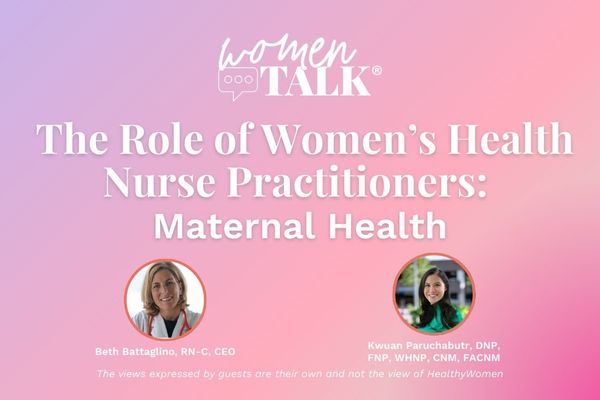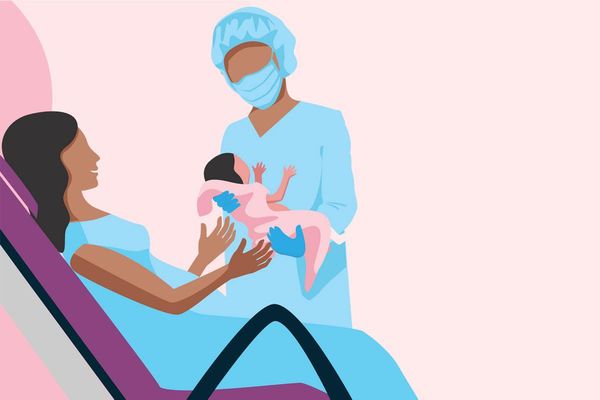With pregnancy comes a lot of question marks. When will you deliver? Is your baby a boy or a girl? What should you name him or her? There can also be questions surrounding your health and your baby's health. To clue you in to some of the unknown, your health care provider may order prenatal tests. These tests look for problems that could signal birth defects or genetic diseases, and the results can help you make the most informed decisions before and after you deliver.
There are two types of prenatal tests: screening tests and diagnostic tests. Prenatal screening is meant to identify women at increased risk for pregnancies affected by disease. Diagnostic prenatal testing is used to confirm whether a pregnancy is affected by a given condition.
Almost all pregnant women in the United States have a maternal serum screening test performed in the first trimester, the second trimester, or both.
The first trimester maternal serum screening test, which doctors usually perform between 11 4/7 weeks and 13 6/7 weeks, provides a probability that the baby might have Down syndrome, trisomy 13, or trisomy 18. The test calculates this probability using the bloodwork results, your age, and information obtained on an ultrasound. The blood sample looks for levels of two chemicals, hCG and PAPP-A. The ultrasound looks for extra fluid behind the baby's neck and absence of a nasal bone. Together with your age-related risk, these results give a picture of the baby's overall risk. Results don't indicate whether your baby definitively has one of these disorders; they just alert you and your doctor if the baby is at an increased risk, so you can undergo further testing if you wish.
The second trimester maternal screening test (also called the “triple screen" or “quad screen") usually takes place between 16 and 20 weeks. Similar to the first trimester screening, the second trimester screen uses a sample of the mother's blood together with her age to assess the baby's risk for Down syndrome and trisomy 18 by looking at level of alpha-fetoprotein, unconjugated estriol, human chorionic gonadotropin and Inhibin A to determine whether the mother is at increased risk of having a baby with one of these disorders. There's also a portion of the screening that assesses the baby's risk for an open neural tube defect, such as spina bifida. , like the first semester screening,
In addition to the first and second trimester maternal serum screening tests, your doctor may offer a cell-free DNA test. With this test, a pregnant woman gives a blood sample after 10 weeks gestation. The test measures small fragments of DNA in the mother's blood to assess the risk of a chromosome problem. Specifically, it looks at the relative amounts of DNA from chromosomes 21, 18, 13, and the sex chromosomes. Cell-free DNA testing can detect over 99 percent of Down syndrome cases, 97 percent of trisomy 18 cases, and 87 percent of trisomy 13 cases.
Maternal Serum Screening Tests and the Cell-Free DNA Test: What they measure:
These tests determine your risk of having a baby with:
- An open neural tube defect. When the neural tube fails to close, the baby is born with an opening in the head (anencephaly) or spinal cord (spina bifida). Babies with anencephaly are stillborn or die soon after birth; those with spina bifida need surgery and may be paralyzed. The severity of spina bifida can vary greatly. One way to reduce your risk of having a child with a neural tube defect is to take folic acid (400 micrograms per day) before conception.
- Down syndrome (also called Trisomy 21). An extra copy of chromosome 21 causes Down syndrome, characterized by mental retardation, certain facial features and sometimes, heart defects.
- Trisomy 18. An extra copy of chromosome 18 causes this syndrome, which usually proves fatal during the first year of the baby's life and is associated with severe mental retardation.
- Trisomy 13. Also called Patau syndrome, trisomy 13 is a chromosomal abnormality that results in severe intellectual disability and multiple physical abnormalities. The physical problems include heart defects, brain or spinal cord abnormalities, small or poorly developed eyes, cleft lip and/or palate, weak muscle tone (called hypotonia), and extra fingers or toes. Only five to 10 percent of children with trisomy 13 live past their first year. Most die within the first few weeks or days of life.
Indeed, most of the time, the fetus is not affected with the disorder, even if the screening result is abnormal. Out of 1,000 serum screening tests, an average of 50 will suggest an increased risk for open neural tube defects, but only one or two of the fetuses will have such a defect. Likewise, an average of 40 out of 1,000 will test positive for increased risk of Down syndrome, but only one or two fetuses will actually have the condition.
Most labs offer the standard "quadruple marker" serum screening test, which detects approximately 75 percent of fetuses affected with Down syndrome among women younger than age 35, and 90 percent of affected fetuses in women 35 and older.
Diagnostic Follow-up in Prenatal Testing
If a screening test indicates a higher-than-average risk of a disorder, your health care professional may want to perform a basic ultrasound, which can help determine the gestational age of the fetus and show if a woman is carrying twins. If either of these factors accounts for the abnormal screen test result, no further testing is needed. Otherwise, a more detailed ultrasound examination may be performed, which allows a look at the baby's brain and spinal cord, as well as other parts of the body. This ultrasound can often identify an open neural tube defect or other malformation associated with an abnormal screening test.
Your health care provider may suggest you consider either amniocentesis or chorionic villus sampling (CVS). Both are diagnostic tests to determine whether the fetus actually has the disorder in question. Amniocentesis is performed more frequently and should be the choice if you're at risk for having a child with neural tube defects (CVS doesn't detect neural tube defects).
If you have amniocentesis, a doctor will use a needle to withdraw a sample of amniotic fluid (the fluid surrounding the fetus) for analysis. The procedure is typically performed during the second trimester, at 15 to 20 weeks.
Amniocentesis or CVS is offered for high-risk pregnancies, which could include any of the following:
- you will be 35 years of age or older at delivery
- your family has a known genetic disorder
- you have had a previous child with a birth defect
- you and your partner are carriers of the same recessive disorder
- other indications as directed by your obstetrician
Both CVS and amniocentesis can cause cramping, and a small number of women have miscarriages following the procedures (the risk is slightly higher with CVS).
CVS is performed at 10 to 12 weeks of gestation and involves analyzing a sample of placental tissue. A thin tube inserted through the vagina and cervix, or the abdomen, and is used to suction out a small tissue sample from the placenta. However, unlike amniocentesis, CVS cannot be used to test for neural tube defects, such as spina bifida and anencephaly. Therefore, it's usually recommended that a woman undergoing CVS also have the prenatal blood test called the maternal serum alpha fetoprotein (MSAFP) screening test, at about 16 to18 weeks of pregnancy.
CVS is more attractive to some women because it can be done much earlier, at 10 weeks to 12 weeks. Many women say that this is a time when pregnancy is still a private issue. But other women feel the slightly higher risk of CVS is unacceptable, and they wait for the amniocentesis. Amniocentesis and CVS can be used to prenatally diagnose many, but not all, genetic disorders. Every prenatal screening and diagnostic test has its benefits, risks and limitations. It is very important to discuss these testing options with your doctor and, if possible, a genetic counselor.
Of course, the ideal time for many tests is before you get pregnant. If you are planning a pregnancy, preconception genetic counseling can be quite helpful, since it offers an opportunity to make decisions without the pressure of an advancing pregnancy. You can identify ptential risks and pursue testing strategies for the planned fetus ahead of time.
Handling the Results
No test guarantees a healthy baby. While amniocentesis and CVS are extremely accurate, they are specific in the types of conditions they can detect. These tests are useful in identifying chromosomal disorders. These tests can also be quite useful if your health care provider suspects a single gene disease. But none of these tests is perfect. Every genetic test is different, and your genetic counselor should accurately describe what each test will and will not detect. These tests do not take into account other factors, including sporadic genetic mutations (without a hereditary component), which may also affect a child's development.
When an untreatable genetic disorder is diagnosed prenatally, parents have the option of continuing or terminating the pregnancy. A genetic counselor can help you learn more about the disorder and weigh your options in a neutral setting. The decision is a tough one, and parents may weigh such factors as whether the disorder can be treated, the family's ability to manage the disorder or disability, the extent to which an affected child will be disabled or in pain, and how long the child is likely to live.
Prenatal testing can also be valuable if you opt to continue a pregnancy knowing your child will be born with a particular disease. The diagnosis can help you, your family and your health care team better manage the pregnancy, the delivery, and any treatment the newborn will need.
In rare cases, a disorder diagnosed prenatally can be treated before birth. For example, congenital adrenal hyperplasia, an autosomal recessive condition that causes genital abnormalities in girls, can be treated with hormones given to the mother. But such opportunities to correct birth defects are still the exception.
Carrier Screening in the Prenatal Setting
Anyone can carry a genetic mutation for an autosomal recessive disease such as cystic fibrosis, sickle cell disease or Tay-Sachs disease without knowing it. That's because carriers of these mutations have no symptoms—in fact, they don't have the disease.
Genes come in matched pairs, except for those on the sex chromosomes. In the case of autosomal recessive disorders, if only one copy of the gene is damaged, the unaffected gene can still function, usually preventing symptoms of the disease. In fact, a disease-causing mutation can be inherited through dozens of generations of a family without anyone showing symptoms of the disease.
With an autosomal recessive disease, if two carriers of the same mutated gene have a child, the chance of both parents passing on his and her mutated copy is 25 percent, in which case the child would have the disease. There is also a 25 percent chance that both parents would pass on their unaffected genes, in which case the child would not have the disease nor be a carrier. Finally, there is a 50 percent chance that the child will be like the parents and will be a healthy carrier (with one unaffected gene and one with a mutation, but not developing the disease).
The exception to this pattern occurs if a disorder is recessive and X-linked. The X is the symbol for the larger sex chromosome. A child who inherits two X chromosomes is a girl. A child with an X chromosome and a Y chromosome is a boy. If a mother has a disease-linked recessive mutation on one of her X chromosomes, she is a carrier of the disorder but should have no or minimal symptoms herself since she has an unaffected X, usually preventing the development of the disease. If the mother who carries an affected X has a son, he will have a 50 percent risk of inheriting the disorder because he will inherit either the mother's affected X or unaffected X. If a male inherits the mother's X which carries a mutation, since a male has no second X chromosome (instead he has Y chromosome, hence being a male), he will then develop the disease. A daughter will have a 50 percent chance of being a carrier, like her mother, since she has inherited her second, functional X from her father.
Fragile X syndrome, as its name suggests, is one such X-linked disorder. The severity of Fragile X can greatly vary. Boys who inherit the mutation usually develop the disease, which is the most common form of genetically inherited mental retardation. Girls who inherit a fragile X mutation are more likely to be carriers, although some females do develop symptoms. If you have a family history of mental retardation, testing can determine whether a Fragile X mutation is responsible and whether you are a carrier.
As with other types of testing, genetic counseling can help you understand carrier screening. A counselor can also help you develop strategies for sharing the information with other family members who may also be at risk of carrying the mutation.
If you have a family member with a known disorder or mutation, you may want to consider carrier screening. In addition, you should consider carrier screening for mutations found frequently in your particular ethnic group. The prevalence of genetic disorders is linked closely to ethnic heritage. Caucasians, for example, have a much higher risk than most other groups for cystic fibrosis, and those of African American descent are more likely to be carriers of mutations that cause sickle cell anemia.
Most carrier screening tests don't sequence an entire gene. Instead they focus on specific mutations known to be common in certain groups. The results are generally accurate (90 to 95 percent). Since most genetic screening tests only look for the common mutations, there is a residual risk that a less common mutation could be missed.
The following are some examples of ethnicities and the conditions that are found more frequently in those groups.
- Caucasians: phenylketonuria, hemochromatosis, cystic fibrosis and alpha 1-antitrypsin deficiency.
- African Americans: sickle cell disease and thalassemia
- East Asians (except Koreans): thalassemia
- Irish, French Canadians and Cajuns: Tay-Sachs disease
- Mediterraneans: thalassemia and familial Mediterranean fever
- Southeast Asians (Cambodians, Laotians and Vietnamese): hemoglobinopathies (disorders of hemoglobin, the oxygen-carrying component of red blood cells)
There are also "genetic screening panels." A panel is typically used for individuals of a specific ethnicity that have a risk for several associated genetic conditions or common mutations for which genetic tests can be performed at one time. One example of a screening panel is the Ashkenazi Jewish Screening Panel. The Ashkenazi Jews are of Central and East European descent, and they account for about 80 percent of the Jewish population in the United States.
The Ashkenazi Jewish screening panel varies depending on the program and laboratory. Some test only for Tay-Sachs and Canavan diseases; other panels may include disorders such as Gaucher disease, Bloom syndrome, Fanconi anemia, Niemann-Pick disease, hereditary deafness and familial dysautonomia.
Many panels also include a screen for cystic fibrosis (CF). This condition is not more common in the Ashkenazi population. Caucasians are more likely to carry CF mutations than other groups. Still, the ratio of the Ashkenazi population that carries known CF mutations is fairly high, about one in 29. Three specific mutations are common in this population, making testing more specific.
Experts Recommend Preconception Screening
You might think that if you and your partner come from different backgrounds, carrier screening is unnecessary. However, the American College of Obstetricians and Gynecologists advises that if one partner in a couple is at high risk and the other is not, the high-risk partner should be screened. If that person tests positive as a carrier, the other partner should be screened.
Genetics experts recommend carrier screening before a couple plans to conceive. Be proactive in seeking preconception genetic counseling. It ensures you the most options, and your genetic counselor can guide you through which screening tests are most appropriate.
If two prospective parents are found to be carriers of a disease, their options include:
- adoption
- use of donor sperm or a donor egg
- in vitro fertilization and preimplantation genetic diagnosis of the embryos
- prenatal testing (If a fetus is identified to carry mutations that could cause disease or disability, some individuals decide to end the pregnancy, while others use the information to prepare for a child having the genetic condition.)
For some recessive diseases, even though an individual has two mutated genes, the clinical severity can vary from patient to patient. Someone with one disease mutation may not have symptoms until middle age, or may go a lifetime asymptomatic, making decisions about testing—and what to do if a fetus turns out to be affected—difficult for prospective parents. It is very important to discuss the details of your genetic test results with a clinician who specializes in interpreting results.
Here are some Questions to Ask if you Pursue Carrier Screening and Preconception Counseling
1. Based on family history and ethnicity, which carrier tests should my partner and I consider?
2. What criteria are you using to determine which tests are right for us?
3. Would other centers recommend a different lineup of tests?
4. What are the options if a result suggests the possibility of having a child with a genetic disorder?
Here are Some Questions to Ask if you Pursue Prenatal Testing
1. How early or late in my pregnancy can this test be performed?
2. What are the risks of the test?
3. Is this a risk screening test or a diagnostic test?
4. What are the options if the test finds a problem?
What's the difference between amniocentesis and chorionic villus sampling? How do I decide which is right for me?
Both procedures provide for diagnosis of specific chromosomal and genetic disorders in the fetus. Amniocentesis is more likely to be offered as a follow-up to an abnormal maternal serum screening test because results of the screen are obtained too late in pregnancy for CVS. However, CVS, which is done at 10 to 12 weeks gestation, or amniocentesis, are offered in the following situations:
- You will be 35 or older at delivery.
- A genetic disorder has surfaced on either side of the family.
- You or your partner has had a previous child with a birth defect.
- You and your partner are carriers of the same recessive disorder.
Both chorionic villus sampling (CVS) and amniocentesis can cause cramping, and a small number of women have miscarriages following the procedures (the risk is higher with CVS). It takes one to two weeks to get results from either test.
Amniocentesis is performed more frequently and should be the choice if you're at risk having a child with neural tube defects. The procedure is performed at 15 to 18 weeks of pregnancy.
CVS can be performed earlier, at 10 to 12 weeks, and is popular with parents who would like to know results before the pregnancy starts to show. The procedure is not available everywhere, however.







